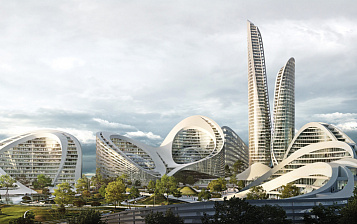Spread among the mountains is a beautiful, rich in sights, country. Sunny, fragrant, cheerful. Not the most popular destination for tourists before, today it is gaining more and more admiring reviews. This is a country of delicious food, beautiful landscapes and colorful recreation. People come here to relax, find peace of mind and get acquainted with such a non-standard atmosphere that prevails in all corners of the country.
Armenia occupies only 151 places in terms of area in the world. But its fertile land is so generous that there is no such area in which the Armenians would not succeed. Singer Charles Aznavour, tennis player Andre Agassi, artist Ivan Aivazovsky, plastic surgeon Varazdat Kazanchyan, Deputy Prime Minister of the USSR Anastas Mikoyan, director Sergei Parajanov - the names can be listed for a very long time.
Armenians love their country very much and love to talk about it. This is not surprising, because they have a lot to tell. Even the most remote village has its own little attraction, which the inhabitants are very proud of. What can we say about the main, brightest points on the map of this sunny country.
Magical ancient temples, perfectly inscribed in the landscape, remain the hallmark of the Armenian mountains. But traveling around the country, it would be unforgivable to focus only on them, passing by fantastic lakes and small authentic cities.
The journey begins with a walk around the capital - Yerevan
Yerevan will charm you at first sight. Turn off filters when taking pictures, you won't need them. The historical center is unique in its color performance. In the 20s of the last century, the city was reconstructed under the leadership of the architect Tamanyan. Yerevan takes on a new look in pink tones. For the cladding of buildings, they begin to use a rare and very beautiful rock - pink volcanic tuff.
First of all, of course, you need to walk around the center, which is quite possible to do in one day.
Visit places such as: Republic Square; Grand opera; Grand Cascade; North Avenue street. Republic Square is literally the heart of Yerevan, where the Government House is concentrated, “dancing” fountains and a hotel are turned on every evening. All this together forms a kind of "trapeze" where people always walk, whether it is day or night.
The Grand Cascade is an observation deck where you can climb either on escalators or on foot and look at Yerevan from above. A very beautiful place, decorated with flowers and greenery, where various monuments are also installed.
North Avenue Street is a long street where all the boutiques and houses with expensive apartments are located. Walking along this street is more pleasant and interesting in the evening, since it is at this time that life in the center of Yerevan really begins to boil.
Special connoisseurs of ancient manuscripts can visit the "Matenadaran" and it is advisable to buy a tour to find out more information about each of them.
As in any eastern city, Yerevan has a large market located on Aram Street. It is called "Vernissage" and everything is sold there: from silver jewelry or souvenirs to musical instruments and antiques.
Sevan
The first and most obvious outing from Yerevan is to the mountain lake Sevan, the real Armenian sea, which occupies a much larger place in the heart of every inhabitant of the country than the twentieth part of the map of Armenia that the stingy hand of geography has measured out for him. In the summer, half of Yerevan is saved from the heat and stuffiness here - fortunately, you can drive from the city to Sevan in an hour. In 1930, Osip Mandelstam, who sang local charms in his “Journey to Armenia”, stayed here: “What can I say about the Sevan climate? The golden currency of cognac in a secret cupboard of the mountain sun.
Since then, the water level in Sevan has noticeably decreased, so that the island with the thousand-year-old monastery of Sevanavank, where the poet enjoyed the lake idyll for a month, is now connected to the shore and serves as the most popular vacation spot for Yerevan residents with all the ensuing consequences. In search of solitude and untouched beauty, it is worth driving along the southern shore of the lake to the ancient monastery of Ayrivank, which literally grows above the water on a high rock covered with red and green lichen.
But Sevan is not only gray-haired antiquities, constantly changing weather and harsh mountains hanging over the lake surface. For local residents, these are, first of all, fish restaurants, which are literally built up on the shore of the lake next to the road. Since ancient times, Sevan has been famous for its special delicacy - royal trout, or, as the Armenians call it, ishkhan. Now the competition for ishkhan, a rare and expensive fish, in the menu of local establishments is whitefish - in the form of shish kebab or grilled.
Vayots Dzor
Perhaps the richest region of Armenia in terms of ancient monuments is the mountain gorges in the south, known as Vayots Dzor, the “Gorge of Wailing”. Now the main highway of the country passes here, connecting Yerevan with Iran and Nagorno-Karabakh. And once these were hard-to-reach places in which the local population could always find refuge from the next conquerors. The heyday of Vayots Dzor fell on the XII-XIV centuries, when under the rule of the princes from the Orbelian family, these gorges remained the only prosperous and independent region of Armenia. The coat of arms of the Orbelyans - an eagle clutching a calf in its claws - still flaunts on almost every temple in the district.
For the traveler who crossed the hills from Yerevan and the Ararat valley, Vayots Dzor begins in the village of Areni. Together with the neighboring village of Getap, it is the capital of Armenian winemaking. According to legend, the first thing Noah did when, after the Flood, his ark was on top of Ararat, he planted a vine. And although it is far from Areni to Ararat, this does not prevent the locals, almost in all seriousness, from building their vineyards to the biblical ancestor. Wine is sold here everywhere, even on the side of the highway, but it’s better to look at any of the handicraft wineries: usually there is a winepress vat or clay karas in front of the entrance - in such jugs,
dug into the ground, from ancient times they kept wine in these parts. The tasting begins right at the entrance to the cellar-maran - according to custom, the first glass is brought to the guest crossing the threshold. Well, then, as it usually happens in the Caucasian outback, lavash, cheese, greens appear from somewhere, table conversations begin - in a word, don’t even count on getting off with a quick visit.
From those times when Areni was the residence of the Orbelian princes, on the hill near the village there is a slender church of the Holy Mother of God built by the most famous architect and sculptor of medieval Armenia, master Momik. Unfortunately, there are few of the fabulous reliefs left here, most of them perished along with the dome of the church, which collapsed during one of the earthquakes. To get some idea of Momik's skill, you should turn off the highway and drive along the most beautiful canyon with bright red rocks to his main work - the Noravank monastery. In this monastery, Momik erected a two-story church of the Virgin, the lower floor of which was used as the princely tomb of the Orbelyans, and the upper one was used as a memorial church.
On the mountain peaks of Vayots Dzor, the remains of many medieval fortifications have been preserved, but few of them compare with Smbataberd, the most imposing castle in Armenia. Climbing to the top of this mountain above the village of Yeghegis, scaring away the threadflies, is worth it even for the sake of sight alone: a sharp triangular cliff, along the edges of which powerful fortress walls snake, cuts the mountain range with a ship's bow. Directly on the course on the neighboring mountain, you can see the ancient monastery of Tsakhats-Kar (by the way, another half-day walk), and on the left and right along the side two abysses gape, at the bottom of which runs along the river and look out from the green crowns deaf villages.
As a base for trips around Vayots Dzor, it is most convenient to use Jermuk with its mountain coolness and old-fashioned sanatoriums of Stalinist architecture. The main Armenian resort is spread around a picturesque gorge among the hills, from one of which a statue of a deer, a local symbol and talisman, looks at the city. According to legend, this animal opened local healing springs to people: fleeing from the persecution of hunters, the shot deer rushed into the river, and jumped out of it alive and healthy. The first plans to set up a resort here on the model of the then fashionable German hydropathic clinics were put forward as early as the 19th century, but they were realized only in 1956, when an openwork Gallery of Mineral Waters grew in the city center. A healing mineral water of a certain temperature flows from each tap, which is offered to be drunk according to the doctor's prescription, and measured festivities take place around, vacationers ride in a boat on the pond and the resort life flows in its unhurried turn.
Tatev
Few cloisters in Armenia can compare in beauty with the Tatev Monastery. The small noisy river Vorotan has been hewing stones for centuries and has carved a whole canyon in these remote lands, at the bottom of which there are springs with bitter water, which, according to the locals, helps with various ailments. A few years ago, a cable car was thrown across the gorge to Tatev, and now it is possible to cover 6 km across the sky from the village of Halidzor to the monastery in 12 minutes, while earlier the journey along the bottom of the gorge could easily take an hour and a half.
The best view of Tatev opens just from the air - or from the other side of the canyon. Thick monastery walls rise right from the very edge of the sheer cliff. Later, when you get to the monastery, you can walk along the walls. Here, on the edge of the abyss, it is easiest to believe in the local legend, according to which, having completed the construction of the monastery, the master asked God for wings and flew away. This is how the name of the monastery is explained: “Tatev” in Armenian means “to give wings”.
The first temple on this cliff appeared almost in the 4th century, when Armenia only adopted Christianity, and it was consecrated by the baptist of Armenians himself, Gregory the Illuminator. As expected, the church was rebuilt several times, but even the most recently built cathedral that has survived to our times still dates from the turn of the 9th-10th centuries, that is, it was built a century before, for example, the baptism of Rus'. And although Tatev is far from the oldest temple in Armenia, it was he who became a symbol of the antiquity of Armenian culture, giving rise to many sayings like: “Where were all the other peoples when there was already a bath in Tatev?” By the way, the bathhouse of a thousand years of antiquity has also been preserved here.
In 904, unknown craftsmen placed in the monastery courtyard near the church a 9-meter stele of Ghazavan, that is, the Staff, and placed it so cleverly that the stone bulk freely swayed on its pedestal. The fluctuations of the Staff, reaching up to 30 degrees, warned the brethren about the coming earthquake. He managed to survive unscathed even the terrible earthquake of 1931. But after the war, “our Soviet scientists,” as one of the locals disapprovingly remarks here, “dismantled the Staff to see how it works. So they didn’t understand anything, they put it back together - but it doesn’t swing anymore. ”
A trip to Tatev should be planned in the afternoon. With a little luck, patches of clouds will slide down from the mountains, filling the entire canyon. The boundless milky sea, spilling at your feet on a par with the top of the ancient monastery wall - for the sake of this view alone, it was worth not only getting out to Tatev, but even flying to Armenia.
The symbol of Armenia is Mount Ararat
And although it is not geographically located in Armenia, it can be seen from everywhere. It is simply impossible to tear your eyes away from its top, this is a majestic sight. This is not just a beautiful mountain, it is something more for the Armenians of the whole world.
The Yerevan Brandy Factory is called "Ararat" and there is a museum complex on its territory where you can learn everything about the production of brandy. Without a tasting, the tour will seem incomplete, so sip Akhtamar ten-year-old and feel the maturity of fifty-degree Dvin right there.
Food
Delicious food is one of the reasons why people visit this country. National cuisine does not leave anyone indifferent! You have to be prepared to see the hateful weight gain when you get back home, but it's worth it.
Kebabs, kebabs, dolma, kyufta and much more from meat. Also, vegetable stews and salads are insanely delicious due to fragrant vegetables and herbs, and, of course, Armenian bread! Freshly baked lavash or “matnakash” is just an enchanting treat for baking lovers! There is also a lot of fish in Armenia, but the best is considered to be brought from Lake Sevan and it is served in restaurants called “Ishkhan”. There are a huge number of restaurants in Yerevan serving national food and delicious food everywhere! Even in the most inconspicuous eateries, standard shawarma is many times juicier and more appetizing.
Another symbol of Armenia is apricots. They are so praised by sellers with a characteristic accent that the temptation cannot be avoided. Orange, the size of a child's fist, insanely delicious, sweet. And their aroma can be corked in a bottle and inhaled on dark winter evenings, as a cure for the blues.
We bet you have already thought about the dates of the next vacation?


 DOWNLOAD
DOWNLOAD LOOK
LOOK
 Top Content of the Month
Top Content of the Month


